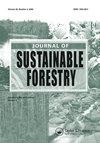Wave effect and shyness phenomenon in homogeneous forests of Alnus acuminata
IF 1.8
4区 农林科学
Q3 FORESTRY
引用次数: 0
Abstract
The wave effect and the shyness phenomenon in Alnus acuminata (Kunth) are crown parameters rarely studied, but important in the quality of the wood of standing trees, therefore, a morphometric modeling of the crowns of Alnus acuminata in homogeneous forests in the Sierra Norte de Puebla was carried out. In 20 rectangular sites of 1,000 m2, the following were evaluated: total height (TA), normal diameter (ND), crown diameter (CD) and crown cover (CC). The Kruskal Wallis test was applied to data that did not meet the assumption of normality; for those that did, analysis of variance (ANOVA) was used, with Tukey mean comparison tests (α ≤ 0.05). The forest value index was 14.99, so its two-dimensional structure is normal based on DN, AT and CC. Its average slenderness index was 93.52, which makes the tree not very stable to mechanical damage. The life-space index was 38.92, which is high indicating that trees with low intraspecific competition developed better. At the canopy level, a pattern following an upward, oscillatory and constant wave effect was observed in groups of 10 trees. The shyness phenomenon showed an average crack opening of 27.39 cm between canopies, so this phenomenon is well defined for the species. It is concluded that in the crowns of Alnus acuminata, the wave effect is observed as a consequence of inequality in the acquisition of resources, and one way to minimize this inequality is through the phenomenon of botanical shyness.针叶桤木同质林中的波效应和羞怯现象
摘要/ abstract摘要:本文对北普埃布拉(Sierra Norte de Puebla)均质森林中针叶桤木(Alnus acuminata, Kunth)树冠的波动效应和害羞现象进行了形态学建模,但这些参数对立木木材质量具有重要影响。在20个面积为1000 m2的矩形样地,对其总高度(TA)、法向直径(ND)、冠径(CD)和冠盖(CC)进行了评价。对不符合正态性假设的数据应用Kruskal Wallis检验;对存在差异的进行方差分析(ANOVA),采用Tukey均值比较检验(α≤0.05)。森林价值指数为14.99,基于DN、AT和CC的二维结构是正常的,其平均长细指数为93.52,对机械损伤不太稳定。生命空间指数为38.92,表明种内竞争低的树种发育较好。在冠层水平,在10棵树组中观察到一个向上、振荡和恒定波效应的模式。羞怯现象表现为树冠之间的平均裂缝开口为27.39 cm,因此这种现象在该物种中是明确的。结果表明,在桤木树冠中,波浪效应是由于资源获取的不平等造成的,而减少这种不平等的一种方法是通过植物羞怯现象。
本文章由计算机程序翻译,如有差异,请以英文原文为准。
求助全文
约1分钟内获得全文
求助全文
来源期刊

Journal of Sustainable Forestry
Social Sciences-Geography, Planning and Development
CiteScore
3.90
自引率
12.50%
发文量
42
期刊介绍:
Journal of Sustainable Forestry publishes peer-reviewed, original research on forest science. While the emphasis is on sustainable use of forest products and services, the journal covers a wide range of topics from the underlying biology and ecology of forests to the social, economic and policy aspects of forestry. Short communications and review papers that provide a clear theoretical, conceptual or methodological contribution to the existing literature are also included in the journal.
Common topics covered in the Journal of Sustainable Forestry include:
• Ecology, management, recreation, restoration and silvicultural systems of all forest types, including urban forests
• All aspects of forest biology, including ecophysiology, entomology, pathology, genetics, tree breeding, and biotechnology
• Wood properties, forest biomass, bioenergy, and carbon sequestration
• Simulation modeling, inventory, quantitative methods, and remote sensing
• Environmental pollution, fire and climate change impacts, and adaptation and mitigation in forests
• Forest engineering, economics, human dimensions, natural resource policy, and planning
Journal of Sustainable Forestry provides an international forum for dialogue between research scientists, forest managers, economists and policy and decision makers who share the common vision of the sustainable use of natural resources.
 求助内容:
求助内容: 应助结果提醒方式:
应助结果提醒方式:


